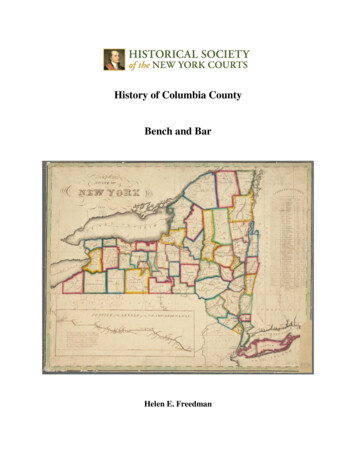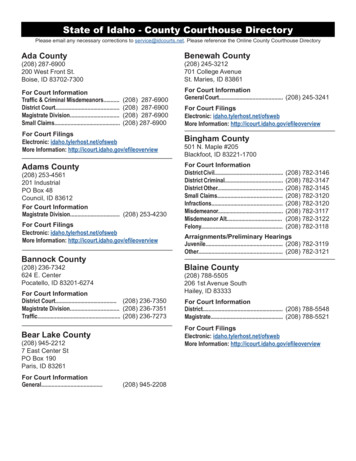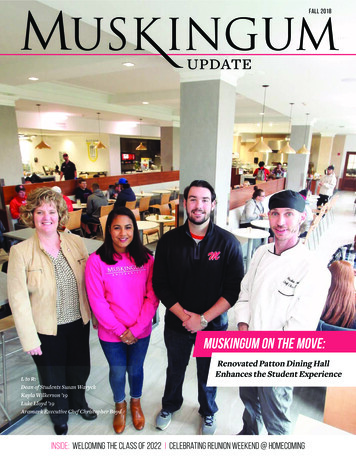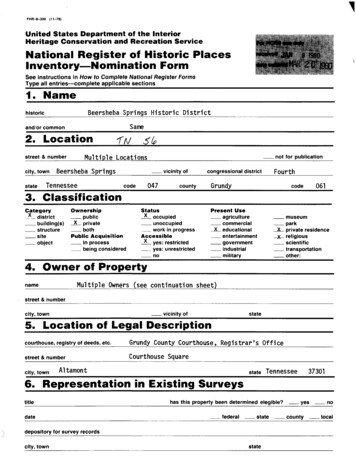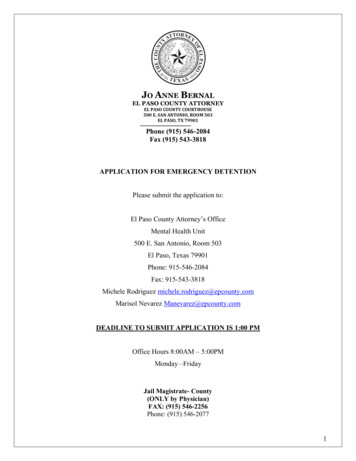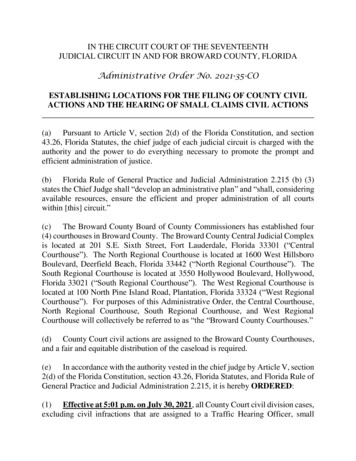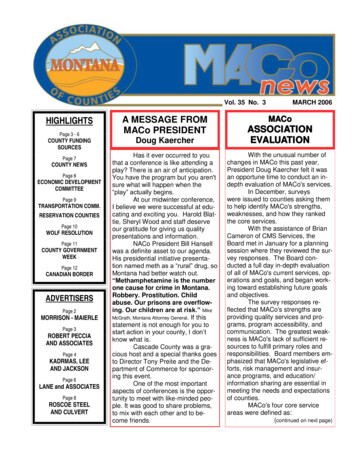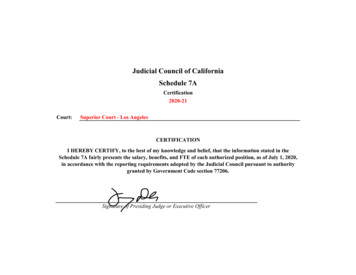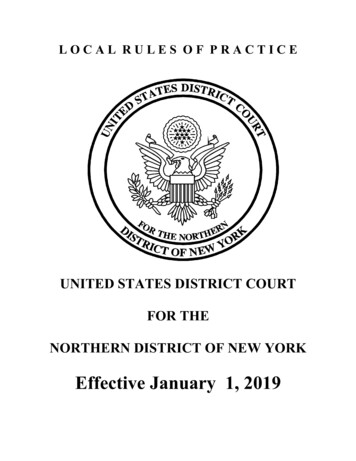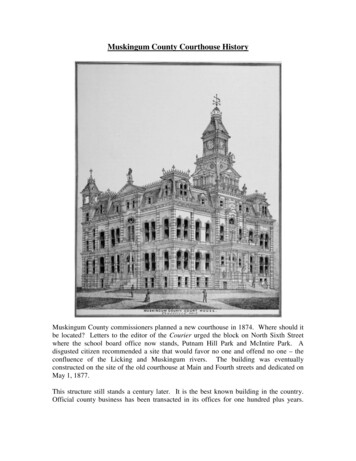
Transcription
Muskingum County Courthouse HistoryMuskingum County commissioners planned a new courthouse in 1874. Where should itbe located? Letters to the editor of the Courier urged the block on North Sixth Streetwhere the school board office now stands, Putnam Hill Park and McIntire Park. Adisgusted citizen recommended a site that would favor no one and offend no one – theconfluence of the Licking and Muskingum rivers. The building was eventuallyconstructed on the site of the old courthouse at Main and Fourth streets and dedicated onMay 1, 1877.This structure still stands a century later. It is the best known building in the country.Official county business has been transacted in its offices for one hundred plus years.
Around its massive limestone walls have surged history and legend, tragedy and comedy,fire and flood.When Muskingum County was formed in 1804, court convened in David Harvey’s tavernon the southwest corner of Main and Third streets. Later sessions were held in othercabinsCounty business increased in volume. Deeds were recorded, marriage licenses wereissued, and wills were probated. Muskingum County needed a courthouse.The present building is the third courthouse on the same corner. On January 25, 1808,the county commissioners authorized construction of the first building. CommissionersHenry Newell and Jacob Gomber voted in favor of the project. But the third member,William Whitten, was shocked at the extravagance of the cost - 480.00.The majority ruled. In 1808 a two-story, hewed-log building was raised near the backsteps of the present courthouse. Court was held on the second floor, and the jailer for theadjoining log jail lived in the first story.A year later another courthouse was built in front of the new one. Why? It was notneeded in this frontier community. The answer is: For political reasons. Chillicothe wasnot well located to be the capital of the state. The legislature was seeking a more centralsite.Both Springfield (now Putnam) and Zanesville leaders had the same idea. If a completedbuilding could be offered as a statehouse, the chances of securing the state capital wouldbe improved.The Springfield School House Company built the imposing Stone Academy that stillstands on Jefferson Street. The Zanesville Courthouse Company, led by John McIntire,spent 7,500 to erect an elaborate brick structure in imitation of Independence Hall inPhiladelphia on the site of the present building. Neither town deceived the other as to itsreal intention.The “School House Company” failed to secure the capital. McIntire and his associateswere successful – temporarily. More shrewd politicians outwitted Zanesville.On October 1, 1810, the legislature passed an act to move the capital from Chillicothe toZanesville. But on the next day the members appointed a committee of five to select apermanent site not more than forty miles from the center of the state. That site becameColumbus, and one of the owners of the real estate was a former Zanesville resident,Alexander McLaughlin.Zanesville was capital for only two years, 1810-1812. The community enjoyed manybenefits from that temporary honor. The state printer moved to this town, taverns were
patronized by the legislators, merchants prospered, real estate increased in price andZanesville’s reputation increased.One cold day in February, 1811, an earthquake shook the area. The statehouse steeplevibrated six inches and legislators jumped out the windows. But no harm was done to thebuilding.After that state legislature vacated the building, it was used as the Muskingum Countycourthouse.The Presbyterians of Zanesville and Putnam held services in barns, taverns and homes.They needed a bell to call the members to worship. At the cost of 400 they bought a675-pound bell made by Thomas W. Devering of Philadelphia and secured permission ofthe county commissioners to hang it in the belfry of the courthouse.The bell was used for public events for sixty years. It called children to school, tolled forfunerals, chimed good news at celebrations, and summoned volunteers to fight fires.One night in 1825 some mischievous boys tied a string to the clapper and unwound theball across Main Street to the roof of a building on the south side. Then they sounded afire alarm. Frustrated and angry volunteers responded three times that night. Nextmorning a piece of string dangled from the bell, but the identity of the boys was neverdiscovered.Some of these boys grew up to patronize the Zanesville Athenaeum. Incorporated as aprivate library in 1828, the members needed a building. In 1830 the countycommissioners leased land to the Athenaeum on the east side of the courthouse for onethousand years for an annual rent of one cent. The stockholders built a two-story brickwing on this site at a cost of 3,500.Meanwhile the fifty-foot square former statehouse was too small for county business. In1833 the commissioners authorized construction of a two-story brick wing on the westfor county offices at a cost of 3,642. The old state capitol with two wings gave servicefor forty more years.While the two wings were being added to the old statehouse, workmen on the NationalRoad spread crushed limestone along Main Street and westward to Columbus and beyondto Vandalia, Illinois. They erected a milestone at the intersection of Court Alley andMain Street. It contained this inscription: “Wheeling, 71; Cumberland, 204; Baltimore,340.”The milestone stood intact until the 1950’s. Then automobiles rounding the cornerbegan to chip pieces away from the 125-year old marker. By 1970 the entire stone wasgone. The National Road nourished the growth of Zanesville business and industry, butcivic leaders wanted more modern transportation. They helped to secure the MuskingumRiver improvement in 1841 and the first railroad in 1852.
In 1861 the quiet of the courthouse lawn was broken by men hurrying back and forth.They were recruiting soldiers for President Lincoln’s army. Reverend C. C. McCabestood on the steps and sang “We are coming, Father Abraham” to encourage enlistments.The courthouse was the scene of frenzied activity in 1863 when Confederate GeneralJohn Morgan approached with his raiders. The clanging of the old bell in the cupolasummoned a crowd. T. J. Maginnis, chairman of the Military Committee, read GovernorDavid Tod’s appeal for men to hunt for Morgan. Next day a thousand rifles with fortyrounds of ammunition apiece arrived from Columbus. Bells rang, stores closed, crowdsjammed Main Street in front of the courthouse to hear the news. About 11:45 couriers onhorseback galloped up to announce that Morgan had crossed the river at Eagleport.Zanesville people heard the news of the fall of Richmond on April 3, 1865. The CivilWar was ending. Crowds “filled the sidewalks and grogshops to excess” said the CityTimes. Flags waved, bands played, bonfires blazed, skyrockets flashed all day. At nightMcCabe, who sang “The Battle Hymn of the Republic.” After several speeches thecrowd sang “Praise God From Whom All Blessings Flow” and went home. Similarrejoicing greeted the news of Lee’s surrender.Before the Civil War the need for a new courthouse had been discussed. The ZanesvilleCity Times said in 1858 that the storage areas were “damp, moldy places without anyconvenience to store away with any kind of order the valuable records of the county.”The story added that several years earlier the commissioners had considered spending 6,000 for repair but decided the building was not worth that expense.Meanwhile a state law required that deeds and mortgages be indexed.Thecommissioners employed J. J. Ingles in 1869 to do the tedious and extensive work ofindexing more than 80,000 deeds.A reader of the Zanesville Courier wrote this vivid description of conditions to the editor:“Taxpayers, do you know your deeds and court records are in great danger of loss bothby fire and by theft? Enter the old building and see for yourself.“It is hung with stove pipes hung about from room to room, and from stove to flue, asthick as cobwebs in a deserted rookery. These pipes are hung on slender wires fastenedinto plastered walls with six ounce shoe tacks. There is nearly 200 feet of such pipe. Thedraft produced is fearful from cannon stoves heated to the red.“In the clerk’s private room the stove pipe hugs the dry pine stairway at a distance of afew inches, punctures the second floor and ends in a brick flue. The cases and valuablefiles of the clerk’s blister and smell when this apparatus is half heated for comfort on awintery day.
“In the recorder’s office, within 40 inches from the records, there is a fire machine that, ifseen by every voter in the county, would cause them to hurl from the office in hot hasteany officer who would plead parsimony when the hazard is so fearful.”That writer had reason to be fearful. Three months later smoke poured from the windowsand the belfry. Someone had fired a coal stove, and the pipe between ceiling and floorbecame red hot and ignited the joists. A section of the second floor was burned, andwater from the fire hose dripped through the floor to the courtroom. Court adjourned toOdd Fellows Hall.These hazardous conditions left no doubt about the need for a new building. In June,1872, the county commissioners – William Hall, Daniel Hatton and Leonard Stump –voted a levy of one mill on the dollar of taxable property for the erection of a newcourthouse. Since the grand duplicate was 27,000,000, it was expected that the levywould amount to 270,000.Legislative approval was needed at that time for the issuance of bonds. William H. Ballintroduced a bill in the legislature authorizing the commissioners to issue bonds of thecounty for construction of a new courthouse.This was probably the largest appropriation since formation of the county. It wasjustified by the deteriorated condition of “Old 1809.” And it received the approval oftaxpayers.But there approval ended. Controversy raged over location, materials, design, workmenand decoration. Citizens expressed their gripes in four newspapers – the City Times,Zanesville Germania, Zanesville Courier and The Zanesville Signal. Both the Courierand the Signal published daily editions for the city and weekly issues for farmers inthose days before Rural Free Delivery. There were enough German immigrants here tosupport a paper in their native language.These papers defended their own political parties vehemently and attacked theopposition, sometimes by name, with unrestrained anger. Letters to the editor expressedsimilar wrath. Public officials could not silence or ignore public opinion. Before thedays of football, hockey and gangster movies, journalistic violence entertained readers.For example, the Signal editor, James T. Irvine, wrote about the editor of the Courier:“Shryock is still abusing the county commissioners for building the new courthouse onthe old site, instead of giving up the lot to business purposes.” Irvine correctly remindedhis readers that John McIntire designated that corner for public uses, but he was ignorantof the fact that courts can approve other uses if circumstances justify the change, as thecourt did in the case of the Market House lot.A reader of the Courier wrote on April 3, 1872: “My suggestion is that the newcourthouse be built upon Putnam Hill. There are several acres of land which werededicated to public uses by the proprietors of the ancient village of Putnam It is away
from the noise and confusion of the business part of the city, and is altogether a desirablelocation.”If he thought that buggies and wagons made “noise and confusion,” he should be here tocompare automobile traffic. Putnam had been annexed to Zanesville two days before hewrote. Perhaps local pride motivated him, but Putnam Hill was not seriously consideredas a site.The site suggested by “Public Spirit” in the Courier on June 4, 1873, was more seriouslyconsidered. He wrote: “The proper place to locate it, in my opinion, is the vacant squarebounded by Sixth, Seventh, Center (now Elberon) and North (now Shinnick) streets.” Onthat lot in 1883 was completed the building used as Zanesville High School unit 1907,Hancock grade school from 1908 to 1924, Hancock Junior High until 1954 and since thatdate as the board of education office.On the next day after “Public Spirit” suggested the Sixth Street site, “Progress” wrote aletter endorsing his suggestion. Said “Progress”: “It is a fact known to lawyers andjudges, especially, that a courthouse should not be located on a business thoroughfare.”He argued that “The roar and rattle of iron wagons and every other kind of vehiclefrequently renders it impossible for a jury to hear what a witness is saying when the doorsand windows are necessarily open.”“Progress” seemed concerned about courtroom conditions. But a few days later “IllGotten Gains” attributed another motive to him. “ ‘Public Spirit’ wants thecommissioners to locate the courthouse NEXT TO HIS LOT, and so do I. He and‘Progress’ are circulating a petition among their employees, and so will I My choice isON MY FARM a mile from town.”A petition with 748 signatures in favor of the Sixth Street site was presented to thecommissioners. “Ill Gotten Gains” was right. Location of the new courthouse on SixthStreet would have increased the value of property in the area.McIntire Park was also suggested as a location. “A Tax Payer” wrote a letter saying that“McIntire Park would be good if moved over the river and located where the courthousenow is In ten years at the present rate of increase, it would be in the center of the city.”“Eureka,” disgusted with these selfish arguments, wrote sarcastically: “As eight out ofnine wards will be left out in the cold if it is located in any one, I respectfully suggest, asthe only situation in which equal justice to all wards may be done, that it be situated inthe center of the confluence of the Licking and Muskingum rivers. This situation issufficiently romantic, the danger from fire obviated, the ground will cost nothing.”“Prudence” wanted to enlarge the old building. He said in the Signal: “The nub of thematter is that there is a big job in a new courthouse.” Add a third story and extend theold building backward was his suggestion.
The editor of the Courier opposed this patching up plan. He said: “Zanesville has fewenough breathing spaces now. Rid the whole half square off, from Main to Market, andput up the county buildings in the center and construct handsome, well-shaped lawnsfronting both streets.”What a wise suggestion! But “Won’t You” improved on it in a letter to the Courier asfollows: “Obtain all the ground between Main and Markets streets and Fourth and Fifthstreets, vacate the alleys and erect the courthouse in the center.”That proposal did not receive much consideration, but if it had been adopted the problemof beautifying downtown Zanesville would have been solved a century ago.The commissioners made a conservative choice for a site. They decided to build the newcourthouse on the lot occupied by “Old 1809.”Immediately a barrier arose in front of them. They did not own all the tract from MainStreet along North Fourth to Fountain Alley. The athenaeum held a one-thousand yearlease on its site, and the city of Zanesville claimed part ownership in the entire tract. Acity building stood on the northwest corner. It had served as a hose house, policeheadquarters and council chamber.The Courier urged a fair compensation for the Athenaeum lot. The editor wrote: “Thelibrary has been the means of cheering the sick and afflicted. It has been the means ofkeeping thousands of the youths of Zanesville from bad company. The stockholders ofthe Athenaeum only ask a reasonable consideration for their property so that they canfurnish the people with an opportunity for improving their minds.”The problem was submitted to a jury. After two and one-half hours of deliberation, thejury awarded the Athenaeum 6,500 for the one-thousand year lease. Next day theCourier expressed disappointment that the amount was less than 8,000.Zanesville’s claim was more complicated. John McIntire and Jonathan Zane, owners of a640 acre tract, recorded the plat of a town called Westbourne (now Zanesville) atMarietta in 1802. On this plat lots 5, 6, and 7 of Square 12 were designated for “publicuses.” Did that mean county or town? The county was not formed until 1804, but it soonoccupied most of the public tract, while the town took possession of a small building siteat the corner of Fourth Street and Fountain Alley.The editor of the Courier wrote: “We hope that the city will sell that little spot of groundto the commissioners. They should receive a sufficient sum to erect a new hose houseand watch house on the city grounds, corner of Fourth and South streets.” Thecommissioners finally paid the city 8,000 for the corner of the lot on Fountain Alley.That transaction should have ended the question of ownership. Legally it did. Believingthat the selfish nature of these suggestions approached the ridiculous, “Progress” went tothat extreme by writing in a letter to the editor this alleged proof that the county did not
own the lot: “I am informed that Pumpkin Moore a number of years ago purchased aHairless Horse from a gentleman in Boston for the sum of 2,000 and deeded the said lotin payment of the horse, which deed is duly recorded.”“Progress” further asserted that Moore displayed the horse over the country “for theconsideration of ten cents per head.” That is an absurd story. George S. Mooreconducted a small grocery on South Fourth Street in the 1850’s and acquired hisnickname because he sold many pumpkins. But he did not display a Hairless Horse andhe did not have title to the courthouse lot that would enable him to convey ownership bya deed.With a clear title to the lots, the commissioners could proceed with plans. They engagedHarry Edward Myer as architect. He was born in Buffalo, New York, on December 16,1837, and died in Cleveland on March 19, 1881. His brother was General Albert J. Myer,founder of the United States Army Signal Corps. Fort Myer in Virginia was named forthe general. This information was supplied by the architect’s grandson, who wrote to theTimes Recorder to ask for information. He said: “We don’t even have a picture of mygrandfather.”The commissioners engaged Myer of Cleveland to furnish plans for a fee of 1,500. Hisspecifications and detail drawings were placed on file in the auditor’s office. He waspaid 200 for each trip from Cleveland to Zanesville for supervision of construction.For building material, the commissioners and the architect agreed on limestone. It wasquarried at the White Cottage property of Mrs. Roberts.A Courier reporter described the quarry as follows: “Great care is required in quarryingsome of the largest landings. They must dress six feet in length, three feet in width, andten inches in thickness. A cubic foot of limestone weighs 180 pounds. One of theselandings weighs 2,700 pounds, equal to the weight of almost 14 barrels of flour. Thethickness of this formation is not known; eleven feet has been reached without signs ofthe bottom.” The Columbus Cement Company found that it extends for miles.Ten contractors submitted bids for the job of building the new courthouse. On September3, 1874, the commissioners awarded the contract to Zanesville contractor T. B. Townsendat his bid of 221,657.The last court convened in “Old 1809” on September 11, 1874. At the head of its newscolumn, the Courier printed this farewell: “Good-by, Old 1809.” The district courtmoved to Black’s Music Hall, the recorder’s office to the second floor of the jailer’sresidence, the probate judge to the marshal’s office in the watch house, the auditor toanother room in the watch house and the treasurer to the old Union Hose House.Townsend lost no time in beginning to demolish the old building. He was allowed 1,750 for the old structure. On September 10, 1874, his workmen lowered the bell fromthe belfry. Four days later the stone bearing the date “1908” was removed from its
position over the front door. The old brick was used in constructing the city prison atThird Street and Fountain Alley.By October 9 Townsend had seventeen stone cutters at work, and he intended to increasethe number to fifty. They built a small shed on Fourth Street for work during the winter.The contractor was burning lime at his quarries new White Cottage.On February 5, 1875, the Courier reported “a 2,000 blunder” in establishing the gradefor the foundation of the new structure. The editor wrote: “The base stone on the CourtAlley side is at least 18 inches underground. We learn that the grade was given to Mr.Townsend by an official, and he claims to have followed his instructions to the letter.The Commissioners have ordered the wall to be raised 18 inches.”Captain William Hall of Zanesville was resident superintendent of construction whenwork began. On March 6 the commissioners voted unanimously to replace him byappointing Henry Voth of Cleveland to the job. The editor complained: “It seems to bethe policy of the commissioners to furnish employment to strangers rather than to theirfriends and neighbors.”“Reason” listed more examples of the failure to employ local men and materials in thisletter: “How many Zanesville men have anything to do with the building of thecourthouse?.Where do the men come from that cut stone for the courthouse? Onlyabout half a dozen from Zanesville out of the 50 or 60 stone cutters, the builder has here.“The sandstone trimmings come from Amherst, Lorain County, the iron from Pittsburg,the tile from Europe, the lumber from Michigan. A Cincinnati man does the galvanizediron work and roofing, a Pittsburg man the iron work, a Columbus man the painting andglass. And by a streak of luck or close calculation a Zanesville man happens to get thewhole contract by a small sum of about 3,000 less than any other man.”Five competing newspapers kept watchful eyes on the use of tax money. Whether theywere motivated by political prejudice or public spirit, they had the courage to speak outemphatically.On May 1, 1875, the Republican Courier reported that the cornerstone had been laid thatday without ceremony. The editor wrote under the caption “That Tombstone” as follows:“The good people of Muskingum County never supposed that in one corner of the newcourthouse would be placed a stone upon which would be recorded the names of deadpoliticians, or politicians trembling on the ragged edge of the river What willsucceeding generations say while gazing upon that stone? What comments will theymake upon the representatives of Muskingum County in 1875? Great Heaven forbid!They will ask one another: Were these our ancestors?.Is it possible that these men wereever elected to honorable office? Is it not more probable that some lunatics broke out ofan asylum and came in the night and defaced the beautiful structure?”
That is virulent criticism. What impelled the editor to make these malicious statements?Perhaps a look at the following inscription on the cornerstone will give a clue:L. N. StumpJohn SimsWilliam HallCommissioners, Muskingum CountyA. P. StultzR. H. MorganFrederick GeigerWilliam RuthAuditorProbate JudgeClerk of CourtsSheriffPerhaps what infuriated the Courier editor was not the list of names on the stone but thenames omitted. If the probate judge was named, why not the common pleas judge? Ifclerk of courts and auditor were included, the treasurer, surveyor, recorder and coronerwere equally deserving of mention. Do you suppose they belonged to the other politicalparty?Workmen embedded this offensive stone in huge, heavy blocks. All the limestone washauled ten miles from White Cottage by horse and wagon. At Fourth and Main streetsthe hammering by fifty stonemasons created a loud cacophony. To raise the finishedblocks in place, the contractor rigged up a crane with block and tackle. It was slow workto chisel the stones to exact size and hoist them into place. By those slow methods thecontractor did well to complete his contract in two and one-half years.Before the building was completed, Zanesville celebrated the Centennial of the signing ofthe Declaration of Independence. At midnight on July 4, 1976, all the bells in the cityclanged the beginning of the observance. The old courthouse bell was moved to the frontof the new, unfinished structure where it could join the chiming. At sunrise a salute ofthirteen guns thundered from Putnam Hill. Stores and homes were smothered with flagsand bunting. A huge parade halted at the west steps of the courthouse for speeches. TheCourier called the celebration “the grandest event in our history.” A century later theBicentennial Commission did nothing on July 4.Workmen had built the walls up to the tower. It was time to order a clock. Eight daysafter the Centennial program the commissioners gave the contract to Ralph S. Mershon,local jeweler, for a clock made by E. Howard and Company of Boston, Massachusetts, ata cost of 3,000. The winding mechanism was operated by a hand crank that required thelabor of a strong man for half and hour several times a week.When construction was begun in 1874, no tile was made in this country. A year later theAmerican Encaustic Tiling Company began operation in an old pottery on the canal bank.That firm manufactured the floor tile for the new courthouse.Phillip Knopf of Columbus had the contract for frescoing the interior walls. His workerspainted a figure of justice on the wall behind the common pleas judge’s chair. The alertCourier editor called it a “miserable daub.” He suggested sarcastically: “Let the picture
of a cow be made, with one client at the head and another at the tail, pulling, and thelawyers meanwhile milking quietly.”One lawyer, Judge L. P. Marsh, proved that figure of speech in error. He collected asubscription fund to engage Zanesville’s best artist, James Pierce Barton, to paint anartistic figure of justice over the “miserable daub.” It remained for nearly half a century.The esplanade was paved with Belgian flagstone at a cost of 17,000. On the west sideof this area the commissioners erected an elaborate fountain. At the base sat three halfnude maidens gazing into the pool around them while water that spouted from a tallcolumn and filled a basin over their heads covered them with a cooling spray. Objectionswere raised against the fountain at once. Some said the spray annoyed pedestrians. Amore serious complaint was that the “topless” maidens would demoralize the youth of thecity.In the spring of 1877 the county officials moved into the new building. It was animmense, imposing structure in the ornamental eclectic style of the period. From theground to the top of the tower it extended 156 feet. At the base it measured 122 feet, 8inches by 114 feet, 10 inches. Ceilings in the first and second floors were 18 feet high.Over the front portico is the date stone from “Old 1809.” This stone confuses peopleabout the year of construction. But if they would tilt their heads back, they would seethis inscription at the third floor level: “Erected A.D. 1874.”On the northwest corner, the old Presbyterian bell hung in a tower. It not only clangedfor celebrations and tolled for funerals, but after 1879 it tapped out numbers thatindicated the location of fires. Every home had a card listing the number of strokes andthe corresponding section of the city. When crowds hampered firemen, that system wasdiscontinued.A flagpole was erected on the southwest corner. High on the roof above the Main andFourth street porticos stood metal statues of Justice. The figure over the main entranceheld scales in her hand. When a local boy had a tooth pulled, he coaxed the janitor’s sonto admit him to the clock tower. Leaning over the railing, he carefully dropped the toothinto the east pan of the scales.Officials moved in before the formal opening. Wild rumors hinted that there would notbe anything there to dedicate. Deputy Treasurer Robert Silvey and his son were lookingfor a gas leak on the morning of April 3, 1877. The son thought he could find the leak bylighting a match. He found it by an explosion that blew his father across the room andbloodied his face, ripped out a section of counter, scattered currency over the floor andattracted a crowd of people who thought the boiler had burst. The fire was soonextinguished and Silvey’s injuries found to be more painful than serious.The ornate arched windows, carved stone, towers, columns and barn-like third floor atticof the new building added to the cost. But Muskingum County people were proud of the
new and commodious structure. They were not, however, invited to the dedication inlarge numbers.On May 1, 1877, at 2 p.m., the Muskingum County Bar Association and their friends metin the common pleas courtroom to dedicate the new building. E. E. Fillmore, chairman,concluded his introductory remarks by saying: “May we hope that in this place, truth andjustice may prevail, and that right always triumphs over wrong.”On behalf of the commissioners, Frank H. Southard presented the new courthouse to thebar and the public. He said that construction had begun when the board was composed ofJohn Sims, Thomas Griffith and William T. Tanner. John O’Neill accepted the buildingon behalf of the bar and the public. M. M. Granger then delivered a long address on“Muskingum County: Its Court and Bar.”The meeting then adjourned until 7 p.m. Lucius P. Marsh delivered an address on “TheEfficiency of Courts and How Promoted.” His address was followed by selections sungby a quartette composed of Mrs. George Harris, Miss Kate Cassel, James A. Cox andWilliam H. Wilmont. MissClara Ayers accompanied the quartette on the organ. W. H.Ball concluded the meeting with an address on “The Relation of the Bar to the Court andthe Community.”The Bar Association ordered 500 copies of the proceedings published in book for
McCabe, who sang "The Battle Hymn of the Republic." . Before the Civil War the need for a new courthouse had been discussed. The Zanesville City Times said in 1858 that the storage areas were "damp, moldy places without any convenience to store away with any kind of order the valuable records of the county."

